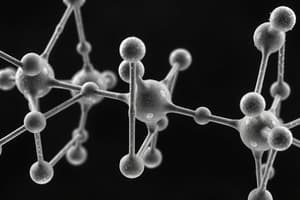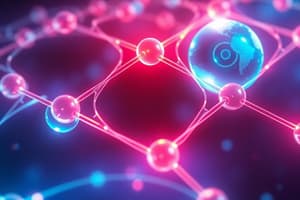Podcast
Questions and Answers
What is the electron geometry of the central phosphorus (P) atom in PF3?
What is the electron geometry of the central phosphorus (P) atom in PF3?
- Linear
- Trigonal Pyramidal (correct)
- Trigonal Planar
- Tetrahedral
What is the shape of a molecule with a central atom that has four electron repulsions, all being bonding electron densities?
What is the shape of a molecule with a central atom that has four electron repulsions, all being bonding electron densities?
Tetrahedral
What is the shape of a molecule when the central atom has four electron repulsions, two bonding electron densities, and two non-bonding electron pairs?
What is the shape of a molecule when the central atom has four electron repulsions, two bonding electron densities, and two non-bonding electron pairs?
Bent
What determines whether a bond is ionic or covalent?
What determines whether a bond is ionic or covalent?
When are molecules and ions the most stable?
When are molecules and ions the most stable?
What does VSEPR stand for?
What does VSEPR stand for?
How many valence electrons are in the molecule COF2?
How many valence electrons are in the molecule COF2?
Flashcards are hidden until you start studying
Study Notes
PF3 (Lewis Structure)
- PF3 consists of a phosphorus atom bonded to three fluorine atoms.
- Phosphorus (P) serves as the central atom in this molecular structure.
Trigonal Pyramidal
- Geometry is determined by the central phosphorus atom's four electron repulsions: three from bonding pairs and one from a lone pair.
- In this geometry, the molecule exhibits a three-dimensional arrangement with a triangular base and a central lone pair above.
Electron Geometry
- The central phosphorus atom should exhibit tetrahedral electron geometry due to the presence of four regions of electron density (three bonding pairs and one lone pair).
- Tetrahedral geometry allows for optimal spacing between electron pairs to minimize repulsion.
Tetrahedral
- The ideal bond angles in a tetrahedral geometry are approximately 109.5 degrees.
- All four electron repulsions around the phosphorus are bonding pairs when considering a tetrahedral arrangement.
Linear
- A linear geometry occurs when there are two bonding electron densities and no lone pairs around the central atom.
- Ideal bond angles are 180 degrees.
Central Atom
- The central atom in a molecule is typically the least electronegative atom, anchoring other atoms around it.
Number of Electron Densities
- Represents regions around the central atom where electrons exist, which may be in the form of bonding pairs or lone pairs.
- Determines the molecular geometry based on VSEPR theory.
Number of Non-bonding Electrons
- Refers to the electrons that are not involved in bonding and are instead present as lone pairs on the central atom.
- Affects the shape and angles of the molecular geometry.
Bent
- Occurs when the central atom has four electron repulsions consisting of two bonding pairs and two lone pairs.
- Results in an approximate bond angle of 104.5 degrees due to repulsion of lone pairs.
COF2 Valence Electrons
- Determine total valence electrons by summing the group numbers of each atom: Carbon (4), Oxygen (6), Fluorine (7×2).
- Total: 4 + 6 + 14 = 24 valence electrons for COF2.
Ionic vs Covalent Bonds
- The bond type is determined by the mechanism of electron interaction: ionic bonds involve the transfer of electrons, whereas covalent bonds involve the sharing of electrons.
Stability of Molecules and Ions
- Molecules and ions achieve maximum stability when adhering to the octet rule, having eight electrons in their valence shell.
Valence Shell Electron-Pair Repulsion (VSEPR)
- A theory used to predict molecular geometry based on repulsion between electron pairs around a central atom.
- Helps visualize and deduce the shape of molecules and their bond angles.
Studying That Suits You
Use AI to generate personalized quizzes and flashcards to suit your learning preferences.




